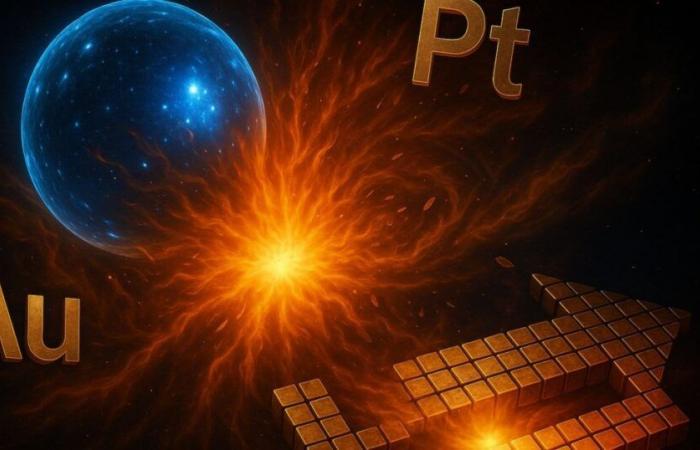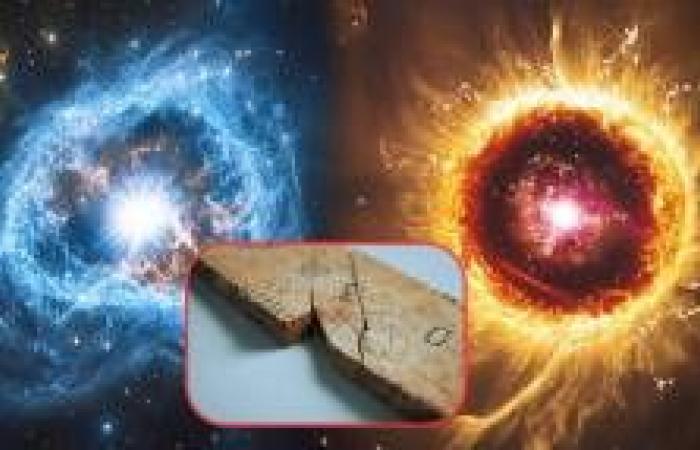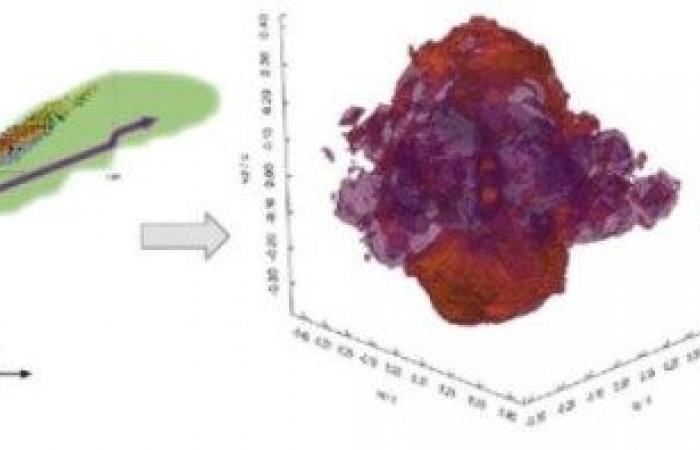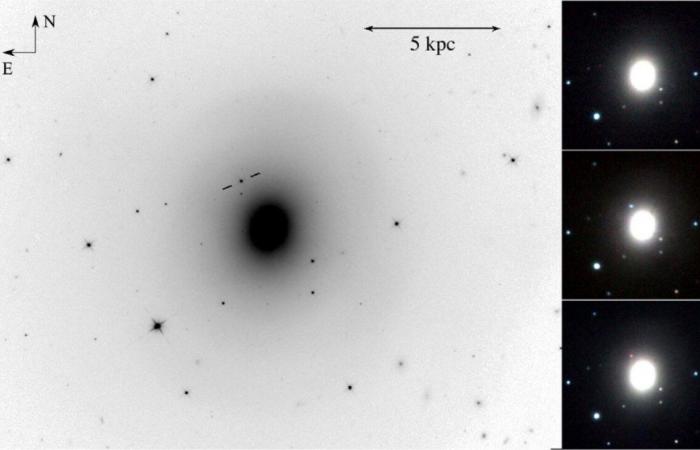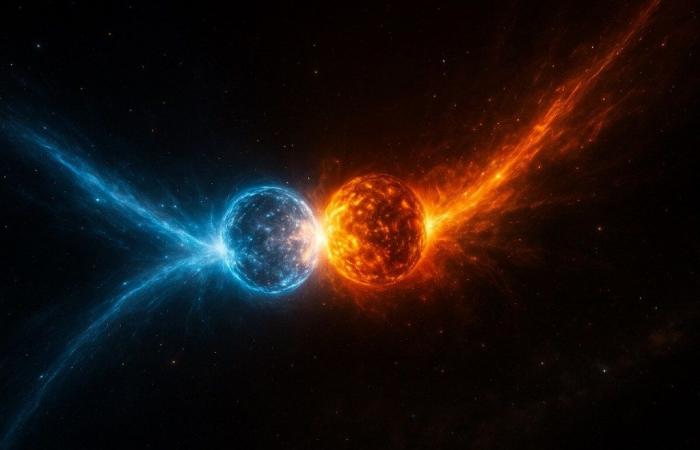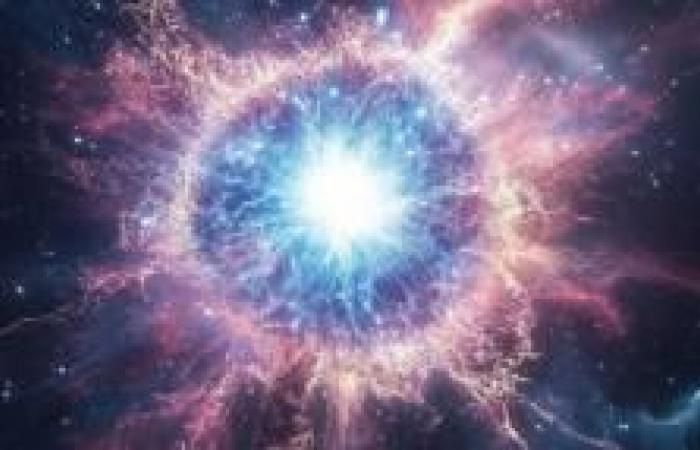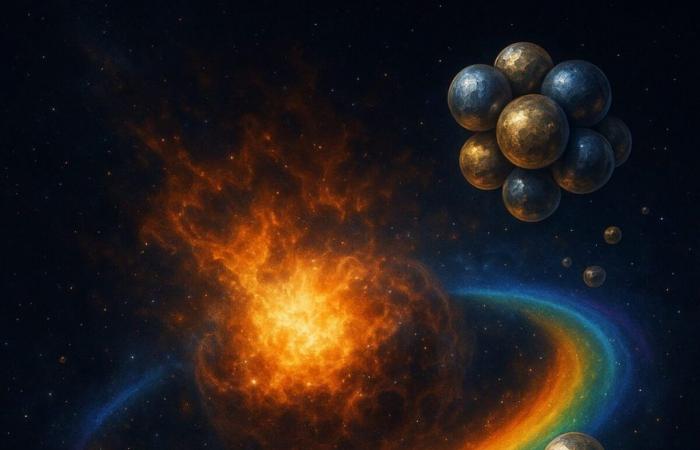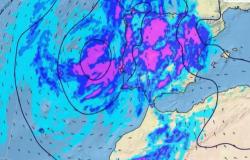Created: 4.05.2025 | 08:42 Updated: 4.05.2025 | 08:55
There are people who ask if it is true that the gold of the earth comes “from the stars.” The answer is yes. Literally. Some of the heaviest and most valuable elements that exist on earth – like gold, platinum or uranium— They are born in the heart of one of the most extreme phenomena of the universe: the kilonovas. These explosions arise when two neutron stars collide, releasing huge amounts of energy and creating new elements through a process known as rapid nucleosynthesis or r process.
A new article published in Philosophical Transactions of the Royal Society A Explore how three -dimensional simulations are being used to better understand the physics behind these explosions. In “Kilono Simulations: Connecting Observations with the Underlying Physics”, Christine Collins, Luke Shingles and Vimal Vijayan show how Advanced simulations allow connecting the data we see in telescopes with what really happens during the fusion of neutron stars. The study is based on models that simulate from the collision to the resulting light spectrum, and poses a fundamental question: how does that fleeting light translate into a chemical firm that we can interpret?
A brightness that reveals the origin of gold
Kilonovas are luminous explosions that last just a few days, but their footprint lasts in the matter itself. They occur when two neutron starsthe dense remains of past supernovae, They revolve around another to collide. This collision releases part of the matter to space, generating ideal conditions for the call Process rwhere atomic nuclei capture neutrons at high speed and form new elements.
One of the most emblematic cases was the event AT2017gfoobserved in 2017 as the electromagnetic counterpart of the gravitational wave signal GW170817. It was the first time that visible light of a kilonova was detected. According to the article, “the AT2017GFO Bolometric Light Curve is consistent with the disintegration of material that R-Process has suffered.” In other words, that explosion first confirmed that the kilonovas Yes Manufacture Heavy Elements.
This finding was fundamental, but He left many unknowns. How much material is exactly expelled? What elements are formed and in what quantities? How does the geometry of the explosion influence what we observe from Earth? The answers, according to the authors, can only be found through simulations that recreate each stage of the phenomenon.

Not the supernovae that manufactured heavy metals?
It is a frequent doubt, and makes sense: for decades it was thought that Supernovas were the main source of the heaviest elements of the universe. And they are, but only up to a point. Supernovas manufacture elements such as oxygen, silicon, iron or nickelbut They do not effectively produce the heaviestlike him gold, platinum or uranium.
These elements require an environment with many free neutrons and extreme density conditions, such as those that occur when Two neutron stars collide. In this merger, jets loaded with neutrons are released that, when cooling, form new nuclei through the Fast neutron capture process. From the AT2017GFO event observed in 2017, the kilonovas are considered the Main source of these heavy metals In the universe.

Simulate chaos: the approach from the direct model
There are two main approaches to study Kilonovas. One is the inverse modeledthat part of the observations and tries to deduce what conditions could have generated them. This method requires many assumptions about density, the composition of the expelled material or the distribution of temperatures. The second is the Direct Modeling Forward Modellingwhich begins simulating the collision itself and continues the whole process until the light it should produce predict.
In this article this second approach is adopted. “Radiative transfer simulations discussed in this article use a direct modeling approach to simulate kilonovas from the merger to the observations.” The team used three -dimensional codes that allow to follow the flow of energy and matter in all directions. The simulations started from a collision between two stars of 1.35 solar masses, using a state equation known as Sfhowhich defines how matter behaves at extreme densities.
An interesting feature is that simulation includes only what is known as Dynamic ejectthat is, the material expelled immediately after the collision. Although this represents only a part of the total, it is considered that it has an important weight in the early hours of the event, when the broadcast is brighter.

The importance of looking in three dimensions
One of the most remarkable aspects of the study is the use of simulations three -dimensional. Many previous research simplified the problem assuming a spherical geometry, which is unrealistic. The subject expelled in a kilonova is asymmetric: density and composition vary according to the address.
The authors underline that a simulation in a dimension cannot capture these details. “A unidimensional simulation of average ejeta spherically does not reproduce any line of vision in the three -dimensional model.” For example, from the poles, the observer can see more light material, which lets out blue light; While from Ecuador the broadcast may seem more dim or more red, due to the presence of heavy elements such as lantanids.
This nuance is crucial, since it affects the interpretation of the data. If too simplified models are used, you can underestimate the amount of material ejected or interpret badly what elements are present. The conclusion is clear: without 3D models, our interpretations are at risk of being wrong.
Spectra, atoms and periodic table
A kilonova produces a spectrum of light that contains clues about the newly created elements. But to interpret these signs it is necessary to have precise atomic data. This is where another problem comes in: many of the elements of the R-Process are rare, and There is not enough experimental information about them.
The study compares two atomic data sets: one purely theoretical (AD1) and another that incorporates experimental data for elements such as Strontium, Ititrium and Circonium (AD2). “By replacing only SR atomic data, and and Zr with calibrated data, the resulting spectra change dramatically.” This not only affects individual lines, but also the total brightness and the color of light.
The difference is so significant that it can make a blue signal look red, or that an element is “lost” in the spectrum. Therefore, the authors underline that to correctly interpret a kilono and determine your contribution to the periodic tableWe need so much complete atomic data as precise.

What tells us all this about AT2017GFO?
Although the simulation presented does not conform exactly to the data of AT2017GFO – because it uses less ejected mass and does not include all components – the similarities are notable. Especially the spectrum simulated from the poles evolves very similar to the observed In AT2017GFO.
“We found a good concordance in spectral evolution, although our model was not adjusted to coincide with AT2017GFO.” This reinforces the idea that, even with limitations, three -dimensional simulations offer a solid base to interpret this type of events. It also allows you to anticipate that, in future kilonovas, they could be observed important variations depending on the viewing angle.
An interesting point is that, even from Ecuador – where a greater presence of heavy elements is expected -, Blue light does not disappear completely. This implies that kilonovas can have an observable blue component in almost any direction, which is useful for detection in distant events.

References
- Collins C, Shingles L, Vijayan V. 2025. Kilonova simulations: connecting observations with the underlying physics. Philosophical Transactions of the Royal Society A, 383: 20240119. https://doi.org/10.1098/rsta.2024.0119.
- Coulter, DA, Foly, RJ, Kilpatrick, CD, so, D., Siebert, Mr, Simon, JD, … & PAN, Y.-C. (2017). SWOPE SURNOVA SURVEY 2017A (SS17A), the optical counterpart to a gravitational wave source. The Astrophysical Journal Letters848(2), L17. https://doi.org/10.3847/2041-8213/aa90b6.

